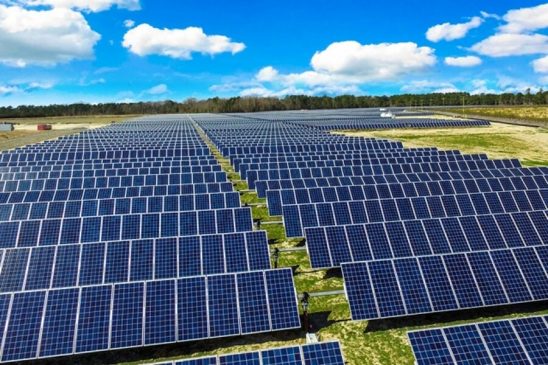Cynobacteria were the earliest life forms to harness photosynthesis leading to the Great Oxidation Event, to which we owe our existence and sustenance. Humans harnessed solar energy with solar cells. Initially, these were manufactured for the space program and remained an expensive curiosity as a terrestrial source of energy. In those times, the high incentives and subsidies given to solar energy program in Germany was considered nonviable by other nations, until the Chinese took benefit of the German solar demand and the economical, large scale and efficient manufacturing of solar modules became a reality.
Their success led to a rapid decline in prices of solar modules and equipment. This prompted other European nations such as Spain and Italy to scale up solar energy programs, thus spurring the demand further. The USA and Europe imposed tariff barriers to protect their domestic solar manufacturing industry, but the Chinese, rather alarmingly, further scaled up the production of solar modules and consumed them, in their enormous and rapidly expanding domestic solar market. Inevitably, and astoundingly, the silicon solar based electricity achieved price parity with fossil fuel based electricity, sometime in 2017. This ushers in a new era of low cost, decentralized green energy for our planet Earth. Further improvements in energy efficiencies are forecast to be achieved by forming blockchain and microgrid based energy trading platforms.
There are three aspects of solar energy; (1) Research and Development of new photovoltaic materials and structures (2) Cost effective manufacturing of solar modules and (3) Deployment of solar modules,
both in utility scale installations and roof top installations. China is now, by far the biggest player in the global solar manufacturing sector. In 2016, 53% of the polysilicon, 60% of the silicon solar cells, and 71% of the silicon solar modules produced in the world were made in China [1]. In case of solar manufacturing, China has achieved supply-chain efficiency and scale of production that is difficult to match by the other solar manufacturing countries.
The cost effective solar module manufacturing and the resulting rapid expansion of solar power is disrupting the economics of staid global electric utilities. In this new scenario, a new term called ‘prosumer’ has emerged, which describes the dual role of producing and consuming the decentralized solar energy by the electricity customers. The governments of many large nations have planned to make solar manufacturing activities as a strategic priority. The stakes of solar power are clear from the long-running trade battle between China and other countries, over Chinese-made solar products. The proliferation of solar power is inevitable in the long term, due to the importance of low-carbon energy sources, concerns about global warming and the declining cost of solar power. At the present time, the solar energy portion of the global energy mix is small (about 1%). Recent controversial political developments, which attempt to protect domestic solar industries, are slowing the transition to a more economically viable and green energy future for our planet.
A classification of photovoltaic materials can be made into three generations:
First generation: The first generation solar cells are based on monocrystalline and polycrystalline silicon. Dedicated emphasis on cost reduction and improved solar cell efficiency have led to commercial solar modules having close to 20% solar conversion efficiency.
Second generation: The second generation solar cells are based on thin film technology. Thin films of amorphous Silicon, CIS (Copper–Indium–Selenide), Copper-Indium-Gallium-Selenide (CIGS), Cadmium-Telluride (Cd-Te), Heterostructure with Intrinsic Thin layer (HIT) solar cells are being investigated. Solar conversion efficiencies of about 12% have been achieved, and are commercially viable.
Third generation: The third generation solar cells are based on nano-crystals, Dye Sensitized solar cells (DSSC), Pervoskite based solar cells and concentrated photovoltaic cells (which have been reported to have efficiencies upto 35%).
The advent of cryptocurrency ‘Bitcoin’ and the underlying distributed ledger technology (DLT) ‘Blockchain’ [2] were an attempt to implement the multitude of agreements that happen in the background of financial transactions, with cryptographically encrypted digital currency. Blockchain is an immutable distributed ledger that validates and records peer-to-peer transactions without a central authority.
It promises more efficient transactions with lower costs. The ‘Immutability’ of the blockchain is due to utilization of Cryptographic Hash Function. For example, Bitcoin utilizes a Secure Hash Algorithm SHA-256. The blockchain is a linked list of data blocks and hash pointers. The hash pointer of a block contains the address of the previous block and the data with a timestamp.
Any alteration would require the consensus of the whole chain. For this reason, it is not possible to surreptitiously ‘hack’ and change the blockchain data. Blockchain can be considered as a database with some special rules regarding how data is appended. The creation of a consistent database in a blockchain is difficult, slow and expensive as compared to a centralized database. Suitable incentive methods need to be developed for blockchain.
A blockchain database needs to be written at all the nodes, which makes the process slow and expensive, as compared to a single step write in a centralized database. The cost of maintaining a blockchain database is considerably higher than a centralized database. Since the blockchain is decentralized, upgrades have to be made by time consuming consensus. Scaling up a blockchain is slow and expensive.
The emergence of Blockchain based platforms for decentralized, encrypted, peer-to-peer energy trading and distribution can make the utilization of solar energy very efficient and economical. Blockchain based approaches can reduce transaction costs of green electricity distribution, creating a larger number of market participants (producers and consumers). This would accelerate the transition towards a greener, cleaner, and more cost efficient energy distribution and trading.
Solarcoin is a cryptocurrency facilitating peer to peer energy transaction of solar energy. EcoCoin is another blockchain-based platform to allow Person-To-Person trading of solar and other renewable assets. These cryptocurrencies are based on the Proof-Of-Work (POW) consensus algorithm , which requires “mining” and is energy intensive. Bitcoin is also based on POW algorithm. Some newer coins (e.g. Ether, Peercoin etc) are implementing the Power-Of -Stake (POS) algorithm, because they are more energy efficient and economical to implement than Bitcoin.
New Solarcoins can be earned by “mining” and also by incentives provided for generating green energy. Those people who adapt and install solar panels on their buildings, will receive solarcoins from their energy utility company.Among the many organizations,who are making an effort to be a pioneer in this paradigm transformation, I have briefly described the activities of Energy Web Foundation (EWF), which has been formed to unleash the potential of blockchain technology in the energy sector, EWF has plans for (1) identifying, documenting, and assessing the most promising instances of activities, where blockchain implementations can lead to a disruptive improvement and (2) to present a new energy domain anchored blockchain platform that contains all the functionalities to be implemented at scale.
The EWF ensures cross platform compatibility to develop market acceptability. This reduces costs and complexity and eases technology deployment through applications. The increasing acceptance and adoption of blockchain based approaches for green energy trading and distribution would trasform the modern electricity grid. Many layers of government and utility intermediaries would be eliminated. The Energy Web Foundation is on building the energy sector’s core blockchain platform on which others’ applications can settle. EWF’s experience in building real-world applications for their clients, from startups to enterprises, is highly complementary. EWF is helping enterprises in aviation, banking, telecoms, automotive and manufacturing.
[1] Ball Jeffery et al, “ The New Solar System”, https://law.stanford.edu/publications/the-new-solar-system/, 2017.
[2] Nakamoto Satoshi, “Bitcoin: A Peer-to-Peer Electronic Cash System”, https://bitcoin.org/bitcoin.pdf, 2008.




